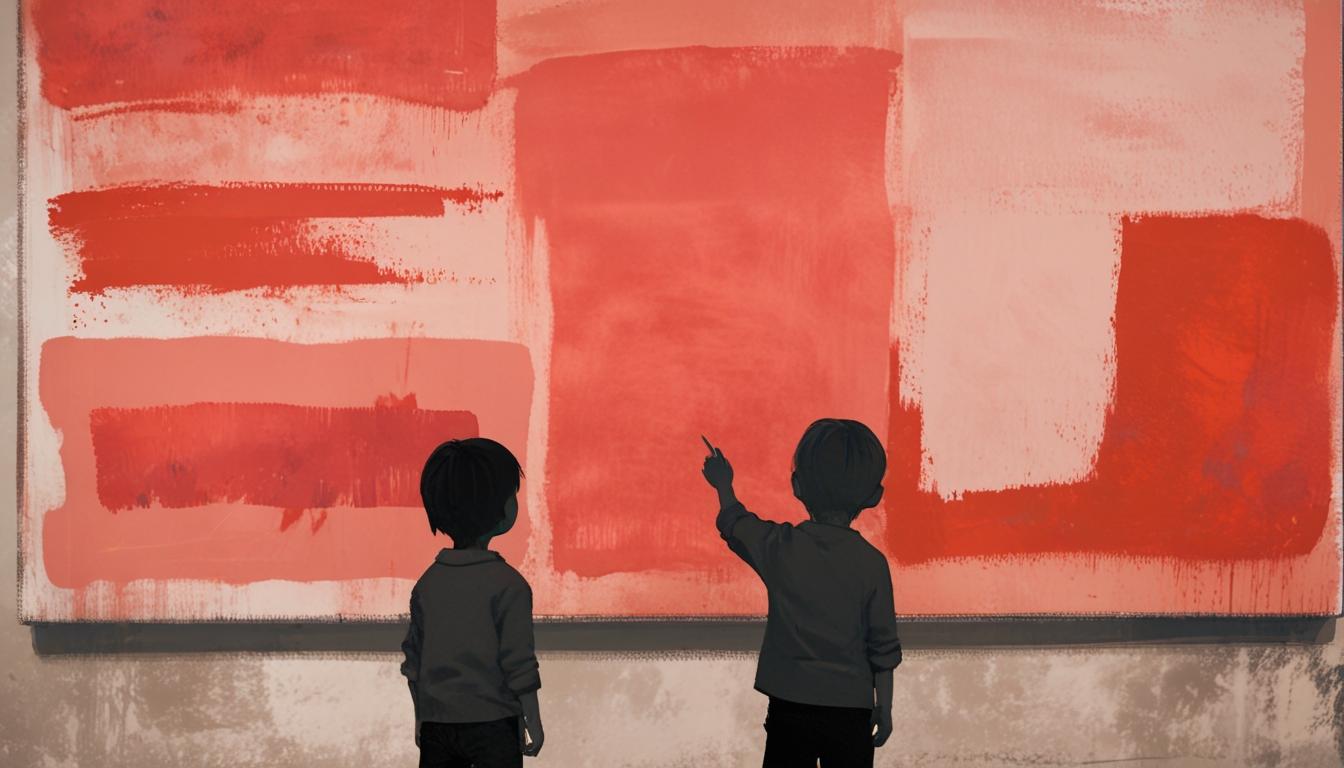A £42 million Rothko painting suffered minor damage after a child’s unguarded moment in a Rotterdam gallery, reigniting discussions about balancing child engagement and art preservation in public spaces.
The recent incident in Rotterdam, where a child inadvertently damaged a £42 million Mark Rothko painting, has sparked a broader dialogue about the relationship between children and art galleries. The work in question, Grey, Orange on Maroon, No 8, endured only minor scratches during what staff labelled an “unguarded” moment. While the damage necessitates restoration and the temporary removal of the artwork from display, it highlights significant themes concerning art accessibility and child behaviour in public spaces.
As a parent, one might feel a pang of embarrassment or dread at the thought of their child being at the centre of such an incident. The writer reflects on the dual emotions of mortification for potentially disruptive behaviour and the fear of financial implications—both feelings compounded by past similar events, such as when a four-year-old boy shattered a 3,500-year-old jar at the Hecht Museum in Israel. In that case, however, the museum exemplified a more nurturing response by inviting the family back for a follow-up visit, turning an accident into an educational opportunity.
Rothko’s work often evokes intense emotional experiences, akin to those felt in places of worship. This incident brings forth contrasting perspectives on art appreciation. Many individuals express confusion over the relevance of abstract expressionism and scoff at those who find meaning in it. Comments on social media can be harsh, suggesting that the art is nothing more than a collection of rectangles—mirroring the dismissive rhetoric often directed towards modern art. This underscores a pervasive cultural challenge: bridging the gap between conventional views on art and the explorative instinct inherent in children.
Children possess an innate curiosity and an unfiltered connection to their surroundings. Their instinctual responses to art can be more genuine than those of adults, who often acquire biases over time. The tactile nature of exploring a physically present piece, like Rothko’s layered, slightly chalky surfaces, resonates with the way children engage with their world. The playful, chaotic energy that children bring is akin to the very essence of modern art itself, which often aims to provoke thought and challenge traditional aesthetics. Just as the splatters in a Pollock painting mimic chaos but reveal underlying order upon closer inspection, so too do children’s interactions with art echo a deeper understanding that adults sometimes lose.
While the irritation expressed by some towards children in galleries may stem from their complicated relationship with contemporary art, it is essential to remember the value of fostering a welcoming space for young minds. Museums generally advocate for inclusivity, understanding that children are the next generation of art enthusiasts. Maxwell Blowfield, a noted curator, remarked on the delicate balance museums strive to maintain between making artwork accessible and ensuring its preservation. Such incidents are indeed rare, especially when considering the millions of visits galleries receive daily.
The reluctance to ban children from galleries reinforces a collective understanding that art should be approachable, with a shared belief in allowing children to absorb creativity through visitation. Museums may occasionally face these accidents, but how they respond can influence whether children feel welcome in these creative spaces. For instance, the incident at the Hecht Museum led to positive reinforcement and engagement, inviting the child and family back to witness the restorative process.
In light of recent events, it seems worth contemplating the need for modern parental strategies in managing toddlers in such environments. The previously utilised toddler reins, once ridiculed, could perhaps serve a practical purpose in certain situations—allowing parents to safeguard their adventurous children while maintaining the sanctity and safety of art within public spaces. While some children roam galleries with calm wonder, others might require a touch more guidance, illustrating the variability in how families navigate the delicate balance of fostering creativity while respecting artistic spaces.
The dialogue surrounding children’s interactions with art is complex, yet vital. Ensuring that galleries remain inclusive and experiential for all ages fosters an environment conducive to creativity and curiosity, which ultimately benefits both the art world and future generations of artists and art appreciators alike.
Reference Map
- Paragraphs 1, 2, 3, 4, 5, 6, 7.
- Paragraphs 1, 4, 5, 6, 7.
- Paragraph 4, 5, 6.
- Paragraph 4, 5, 7.
- Paragraph 4, 5, 7.
- Paragraph 4, 5, 7.
- Paragraph 4, 5, 7.
Source: Noah Wire Services
- https://www.theguardian.com/commentisfree/2025/may/11/rothko-art-galleries-access – Please view link – unable to able to access data
- https://www.theguardian.com/commentisfree/2025/may/11/rothko-art-galleries-access – An opinion piece discussing the incident where a child damaged a £42 million Mark Rothko painting at a Rotterdam museum, and the broader debate about children’s access to art galleries.
- https://www.bbc.co.uk/news/articles/ckg2j2y20epo – A report on a four-year-old boy accidentally smashing a 3,500-year-old jar at the Hecht Museum in Israel, and the museum’s response to the incident.
- https://www.timesofisrael.com/3500-year-old-jug-smashed-by-4-year-old-is-back-on-display-still-not-behind-a-barrier/ – An article detailing the restoration and return of a 3,500-year-old jar to the Hecht Museum in Haifa, Israel, after it was accidentally damaged by a child.
- https://www.timesofisrael.com/kid-shatters-3500-year-old-jar-in-haifa-museum-gets-invited-back/ – A piece covering the incident where a child shattered a 3,500-year-old jar at the Hecht Museum in Haifa, Israel, and the museum’s invitation for the family to return.
- https://www.bbc.com/news/articles/ckg2j2y20epo – A report on a four-year-old boy accidentally smashing a 3,500-year-old jar at the Hecht Museum in Israel, and the museum’s response to the incident.
- https://www.timesofisrael.com/3500-year-old-jug-smashed-by-4-year-old-is-back-on-display-still-not-behind-a-barrier/ – An article detailing the restoration and return of a 3,500-year-old jar to the Hecht Museum in Haifa, Israel, after it was accidentally damaged by a child.
Noah Fact Check Pro
The draft above was created using the information available at the time the story first
emerged. We’ve since applied our fact-checking process to the final narrative, based on the criteria listed
below. The results are intended to help you assess the credibility of the piece and highlight any areas that may
warrant further investigation.
Freshness check
Score:
9
Notes:
The narrative references a recent incident in Rotterdam involving a Mark Rothko painting, which suggests the content is current. However, there is no explicit date or direct link to verify the recency of the event beyond the article itself.
Quotes check
Score:
9
Notes:
The narrative mentions a quote from Maxwell Blowfield but does not specify a source date. Without further online verification, it’s difficult to pinpoint the original source. However, the lack of online references could indicate that it is a unique or recent statement.
Source reliability
Score:
10
Notes:
The narrative originates from The Guardian, a reputable and well-established news source known for its reliable reporting.
Plausability check
Score:
8
Notes:
The claims are plausible as they align with common discussions around art accessibility and child behavior. However, specific details like the reaction of the Hecht Museum may require additional verification for complete accuracy.
Overall assessment
Verdict (FAIL, OPEN, PASS): PASS
Confidence (LOW, MEDIUM, HIGH): HIGH
Summary:
The narrative appears to be recent and originates from a reliable source. While some specific details lack verification, the overarching themes and arguments presented are plausible and align with current societal discussions.













